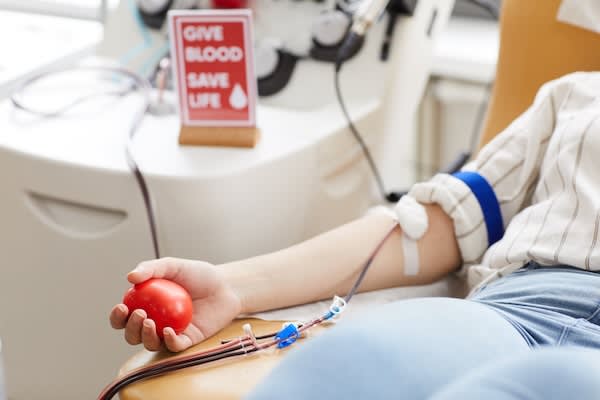
[5 MIN READ]
In this article:
-
Because blood cannot be stored for long, there is a constant need for blood donors.
-
Learn about the different types of blood donation, some myths about the process and the steps required to donate blood.
-
Find out if you’re eligible to donate blood so you can help save one or more lives.
Get the facts about blood donation and save a life
If you or a loved one has ever been in an accident or battled cancer, you know just how important it is to have a steady blood supply. Every day, blood transfusions save lives, but they are only possible when average adults like you donate blood.
National Blood Donor Month in January encourages Americans to give the gift of life by donating blood. It’s especially timely because winter is one of the most difficult times of the year to collect enough blood, resulting in blood shortages. That’s because bad weather often forces organizations to cancel their blood drives, and people who are sick have to postpone giving blood until they’re well again.
“In order to safely receive blood from another person, we have to be tissue-match- and blood-type- compatible with them,” says Robert Lichfield, D.O., a family medicine doctor with Providence in Spokane Valley, Washington. “There are several different types of tissue and blood types. Some are rare, and there are commonly shortages. There is a constant burden for the blood banks to ‘line up the stars’ for many different scenarios. Many donors of many different types of tissue and blood types is an ideal donation dynamic for a community.”
Are you a regular blood donor? If not, would you consider becoming one? Here, Providence gives you some important information about the blood donation process.
What is blood donation?
Blood donation is when a person voluntarily donates blood to be used for transfusions. There is a constant need for people to donate blood, because it can only be stored for a limited amount of time. One donation can potentially save several lives.
Blood donation is mostly safe for the donor, but some people have experienced bruising in the spot where the needle was in their arm, and some feel faint during or immediately after the process.
Who can donate blood?
Hospitals around the country are in desperate need of blood products, but, unfortunately, that doesn’t mean that all donations can be accepted. Generally, donors must meet the following guidelines for eligibility:
- Be in general good health
- Feel well (not actively sick with an illness)
- Be at least 17 years old (or have parental consent if 16 years)
- Weigh at least 110 pounds
- Have not donated blood in the last 56 days
- Meet certain personal criteria, such as not having used needles for drugs for a specific amount of time and not having any infectious diseases
- Meet certain medication requirements
- Have any chronic conditions, such as hypothyroidism, under control
- Have not traveled to certain countries recently
Types of blood donations
There are several blood products needed by health care organizations around our country, and each type serves an important role in saving lives:
- Whole blood. The most common type of blood donation, whole blood simply refers to the blood that flows through your veins. It may be given to anyone who has lost a significant amount of blood, including during surgery or after a trauma.
- Red blood cells. When separated from whole blood, red blood cells (RBCs) can be used to help treat anemia.
- Platelets. Collected during a special process that uses an apheresis machine or separated from a whole blood donation, platelets are often given to cancer patients or individuals undergoing organ transplant surgery.
- Plasma. As the liquid portion of your blood, plasma helps maintain blood pressure, supports immunity, encourages clotting and carries electrolytes to muscles. It is collected during whole blood donation and then separated from the cells and platelets in the blood.
There are also different types of donations in addition to a general donation:
- Direct donation. This is when a person wants to donate directly to another person. They must be a compatible tissue and blood-type match.
- Autologous donation. This is when a person donates their own blood in advance for potential needs they may have. It is usually for a planned or expected surgery.
What to expect during the donation process
When you donate blood, you will generally follow these steps:
- Register. Sign in at the blood center or blood drive and show your identification.
- Go over your medical history and undergo tests. You will fill out a questionnaire and a technician will take your blood pressure and test your hemoglobin level with a finger-stick.
- Donate. A technician will clean the area where you will be donating, insert a needle in your arm and draw blood. The process varies depending on the individual, but it generally takes about 10 minutes to donate a pint of blood.
- Eat and drink. You will need to replenish your blood sugar with refreshments while you rest for 10-15 minutes.
- Recover. You should keep the bandage on for a few hours and avoid strenuous activity for the rest of the day.
Common myths about blood donation
Don’t let myths about donating blood make you hesitant to be a donor. Instead, allow us to debunk these myths for you:
Myth 1: Blood donation is painful
The initial needle stick may hurt, but only for a moment. After that, you shouldn’t feel any pain.
Myth 2: You can get sick from donating blood
If you are healthy before donating blood, you should remain healthy after the donation. However, doctors do recommend that you rest for a day and drink lots of fluids for two days after donating.
Myth 3: I’m not eligible to donate blood
You can’t say for certain whether you’re eligible until you go over the eligibility requirements for donating a unit of blood. Visit the Providence blood donation page to learn more about whether you’re eligible to donate, and where you can donate near your home.
Why is it important to donate blood?
Contributing caregiver

Robert Lichfield, D.O., is a family medicine doctor with Providence in Spokane Valley, Washington.
Find a doctor
If you are looking for a Providence provider, search for one in our provider directory.
Download the Providence app
It’s all in the app: easily stay connected with Providence and your health. With the Providence app, you can schedule appointments, have virtual visits from the comfort of your own home, get health recommendations personalized for you, access your health records and so much more. Learn more and download the app.
Related resources
5 surprising reasons you can’t donate blood
Got 15 minutes? Save three lives.
This information is not intended as a substitute for professional medical care. Always follow your health care professional’s instructions.
About the Author
More Content by Providence Health Team






















